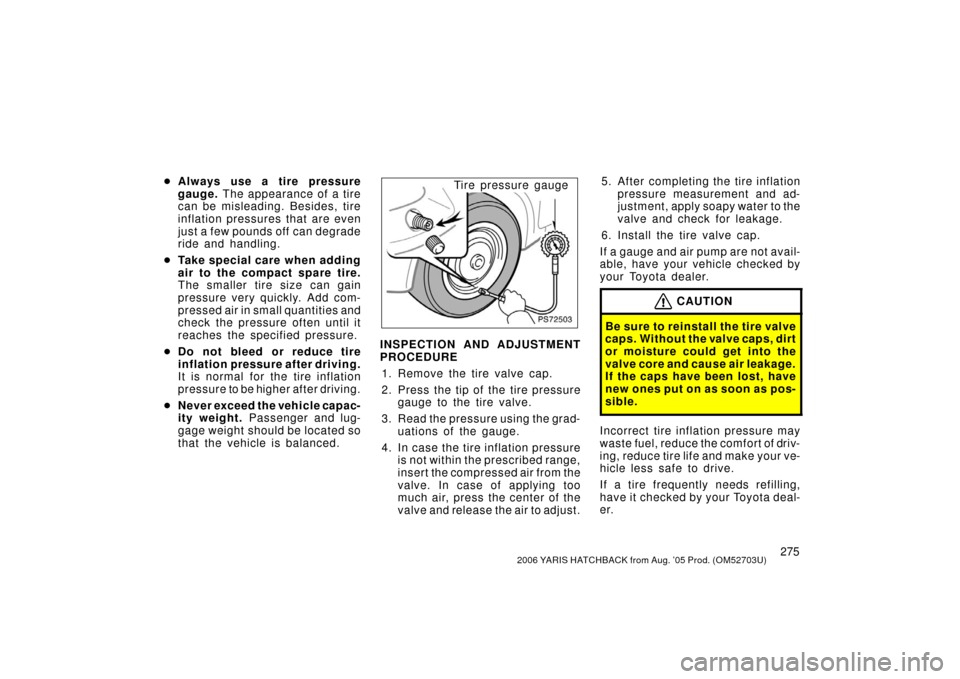Page 236 of 312
2292006 YARIS HATCHBACK from Aug. ’05 Prod. (OM52703U)
NOTICE
Do not continue driving with a
deflated tire. Driving even a
short distance can damage a
tire and wheel beyond repair.
SZ41023
Compact spare tire
The compact spare tire is designed
for temporary emergency use only.
The compact spare tire is identified
by the distinctive wording “TEM-
PORARY USE ONLY” molded into the
sidewall of the tire.
The compact spare tire saves space
in your luggage compartment, and its
lighter weight helps to improve fuel
economy and permits easier installa-
tion in case of a flat tire.The compact spare tire can be used
many times, if necessary. It has tread
life of up to 4800 km (3000 miles) de-
pending on road conditions and your
driving habits. When tread wear indi-
cators appear on the tire, replace the
tire.
See also the tire information in Sec-
tion 7
−2 for details on the tread wear
indicators and other service informa-
tion.
Page 281 of 312

2742006 YARIS HATCHBACK from Aug. ’05 Prod. (OM52703U)
Remove and replace the reservoir cap by
hand. Fill the brake fluid to the dotted
line. This brings the fluid to the correct
level when you put the cap back on.
Use only newly opened brake fluid. Once
opened, brake fluid absorbs moisture from
the air, and excess moisture can cause a
dangerous loss of braking.
CAUTION
Take care when filling the reservoir
because brake fluid can harm your
hands or eyes. If fluid gets on your
hands or in your eyes, flush the af-
fected area with clean water immedi-
ately. If you still feel uncomfortable
with your hands or eyes, go to the
doctor.
NOTICE
If you spill some of the fluid, be sure
to wipe it off to prevent it from dam-
aging the parts or paintwork.
PS72502
Keep your tire inflation pressures
at the proper level.
The recommended cold tire inflation
pressures, tire sizes and the com-
bined weight of occupants and cargo
(vehicle capacity weight) are de-
scribed on page 296 and 299. They
are also described on the tire and
loading information label as shown.
You should check the tire inflation
pressures every two weeks, or at
least once a month. And do not forget
the spare!
The following instructions for
checking tire inflation pressure
should be observed:
� The pressure s hould be
checked only when the tires are
cold. If your vehicle has been
parked for at least 3 hours and has
not been driven for more than 1.5
km or 1 mile since, you will get
an accurate cold tire inflation pres-
sure reading.
Checking tire inflation
pressure
Page 282 of 312

2752006 YARIS HATCHBACK from Aug. ’05 Prod. (OM52703U)
�Always use a tire pressure
gauge. The appearance of a tire
can be misleading. Besides, tire
inflation pressures that are even
just a few pounds off can degrade
ride and handling.
� Take special care when adding
air to the compact spare tire.
The smaller tire size can gain
pressure very qu ickly. Add com-
pressed air in small quantities and
check the pressure often until it
reaches the specified pressure.
� Do not bleed or reduce tire
inflation pressure after driving.
It is normal for the tire inflation
pressure to be higher after driving.
� Never exceed the vehicle capac-
ity weight. Passenger and lug-
gage weight should be located so
that the vehicle is balanced.
PS72503
Tire pressure gauge
INSPECTION AND ADJUSTMENT
PROCEDURE
1. Remove the tire valve cap.
2. Press the tip of the tire pressure gauge to the tire valve.
3. Read the pressure using the grad- uations of the gauge.
4. In case the tire inflation pressure
is not within the prescribed range,
insert the compressed air from the
valve. In case of applying too
much air, press the center of the
valve and release the air to adjust. 5. After completing the tire inflation
pressure measurement and ad-
justment, apply soapy water to the
valve and check for leakage.
6. Install the tire valve cap.
If a gauge and air pump are not avail-
able, have your vehicle checked by
your Toyota dealer.
CAUTION
Be sure to reinstall the tire valve
caps. Without the valve caps, dirt
or moisture could get into the
valve core and cause air leakage.
If the caps have been lost, have
new ones put on as soon as pos-
sible.
Incorrect tire infl ation pressure may
waste fuel, reduce the comfort of driv-
ing, reduce tire life and make your ve-
hicle less safe to drive.
If a tire frequently needs refilling,
have it checked by your Toyota deal-
er.
Page 284 of 312

2772006 YARIS HATCHBACK from Aug. ’05 Prod. (OM52703U)
The tires on your Toyota have built−in
tread wear indicators to help you
know when the tires need replace-
ment. When the tread depth wears to
1.6 mm (0.06 in.) or less, the indica-
tors will appear. If you can see the
indicators in two or more adjacent
grooves, the tire should be replaced.
The lower the tread, the higher the
risk of skidding.
The effectiveness of snow tires is
lost if the tread wears down below
4 mm (0.16 in.).
If you have tire damage such as
cuts, splits, cracks deep e nough to
expose the fabric, or bulges indi-
cating internal damage, the tire
should be repl aced.
If a tire often goes flat or cannot be
properly repaired due to the size or
location of a cut or other damage, it
should be replaced. If you are not
sure, consult with your Toyota dealer. If air loss occurs while driving, do not
continue driving. Driving even a short
distance can damage a tire beyond
repair.
An y ti res wh i ch are over 6 years
old must be checked by a qualified
technician even if damage is not
obvious.
Tires deteriorate with age even if they
have never or seldom been used.
This applies also to the spare tire and
tires stored for future use.
REPLACING YOUR TIRES
When replacing a tire, use a tire of
the same size and construction,
and the same or greater maximum
load as the originally installed
tires.
Using any other size or type of tire
may seriously affect handling, ride,
speedometer/odometer calibration,
ground clearance, and clearance be-
tween the body and tires or snow
chains.
Check that the maximum load of the
replaced tire is greater than 1/2 of the
Gross Axle Weight Ratings (GAWR)
of either the front axle or the rear
axle, whichever is greater. As for the
maximum load of the tire, see the load
limit at maximum cold tire inflation
pressure mentioned on the sidewall
of the tire, and as for the Gross Axle
Weight Ratings (GAWR), see the Cer-
tification Label.
For details about the sidewall of the
tire and the Certification Label, see
pages 191 and 188.
Page 288 of 312

2812006 YARIS HATCHBACK from Aug. ’05 Prod. (OM52703U)
Replacement with used wheels is not rec-
ommended as they may have been sub-
jected to rough treatment or high mileage
and could fail without warning. Also, bent
wheels which have been straightened may
have structural damage and therefore
should not be used. Never use an inner
tube in a leaking wheel which is designed
for a tubeless tire.
CAUTION
Do not use wheels other than the
manufacturer ’s recommended size, as
this may cause dangerous handling
characteristics resulting in loss of
control. Otherwise, an accident may
occur resulting in death or serious
injuries.
Aluminum wheel precautions
�When installing aluminum wheels,
check that the wheel nuts are tight
after driving your vehicle the first 1600
km (1000 miles).
�If you have rotated, repaired, or
changed your tires, check that the
wheel nuts are still tight after driving
1600 km (1000 miles).
�When using tire chains, be careful not
to damage the aluminum wheels.
�Use only Toyota wheel nuts and
wrench designed for your aluminum
wheels.
�When balancing your wheels, use only
Toyota balance weights or equivalent
and a plastic or rubber hammer.
�As with any wheel, periodically check
your aluminum wheels for damage. If
damaged, replace immediately.
Page 302 of 312
2952006 YARIS HATCHBACK from Aug. ’05 Prod. (OM52703U)
SPECIFICATIONS
Specifications
Dimensions and weights296
. . . . . . . . . . . . . . . . . . . . . . . . . . . . . . . . . . . . \
Engine 296
. . . . . . . . . . . . . . . . . . . . . . . . . . . . . . . . . . . . \
. . . . . . . . . . . . . . . .
Fuel 296
. . . . . . . . . . . . . . . . . . . . . . . . . . . . . . . . . . . . \
. . . . . . . . . . . . . . . . . . .
Service specifications 297
. . . . . . . . . . . . . . . . . . . . . . . . . . . . . . . . . . . . \
. . .
Tires 299
. . . . . . . . . . . . . . . . . . . . . . . . . . . . . . . . . . . . \
. . . . . . . . . . . . . . . . . .
Fuses 300
. . . . . . . . . . . . . . . . . . . . . . . . . . . . . . . . . . . . \
. . . . . . . . . . . . . . . . .
SECTION 8
Page 303 of 312
2962006 YARIS HATCHBACK from Aug. ’05 Prod. (OM52703U)
Dimensions and weights
Overall length mm (in.) 3825 (150.6)
Overall width mm (in.) 1695 (66.7)
Overall height mm (in.) 1530 (60.2)
Wheelbase mm (in.) 2460 (96.9)
Front tread mm (in.) 1480 (58.3)
∗1
1470 (57.9)∗2
Rear tread mm (in.) 1470 (57.9)∗1
1460 (57.5)∗2
Vehicle capacity weight
(occupants + luggage)
kg (lb.) 383 (845)
Towing capacity
∗ 3
(trailer + cargo weight) kg (lb.) 318 (700)
∗1: With P175/65R14 81S tires∗2: With P185/60R15 84T tires∗3: For Canada only
Engine
Model:
1.5 L 4 −cylinder (1NZ− FE)
Type: 4 cylinder in line, 4 cycle, gasoline
Bore and stroke, mm (in.): 75.0 � 84.7 (2.95 � 3.33)
Displacement, cm
3 (cu. in.):
1497 (91.3)
Fuel
Fuel type: Unleaded gasoline, Octane Rating 87(Research Octane Number 91) or higher
Fuel tank capacity, L (gal., Imp. gal.): 42 (11.1, 9.2)
Page:
< prev 1-8 9-16 17-24